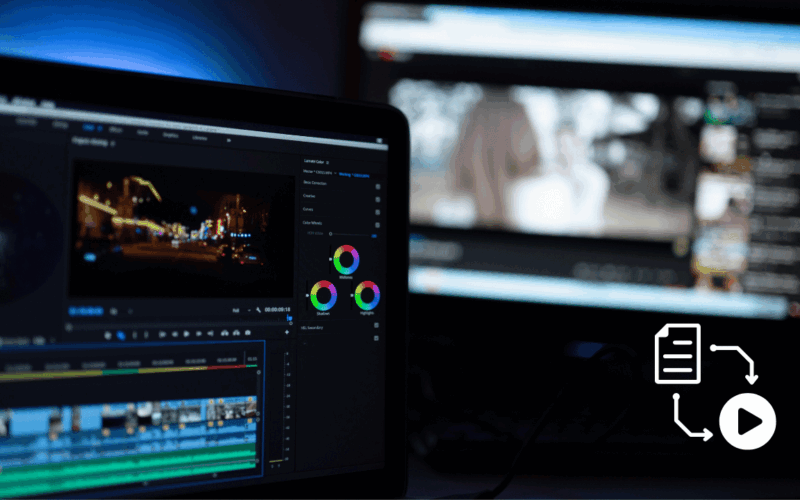AI tools are converting text into video content
We’ve all been there, staring at a blank screen, trying to figure out how to turn a blog post, campaign idea, or product description into something visual and engaging. Creating videos used to mean learning editing software, sourcing voiceovers, resizing for platforms, and spending hours stitching it all together. In this article, we’ll be exploring the AI tools and learn how text-to-video is reshaping content creation today.
But things are changing. Thanks to the rise of AI tools, turning text into video doesn’t require a production crew or editing background. If you’re a marketer juggling multiple campaigns or a teacher trying to make lessons more interactive, AI video tools are making it easier to bring ideas to life, fast.
Here we would how one specific type of tool, “Text-to-Video AI” is helping people turn written content into ready-to-share videos, and why it’s becoming a key part of modern content creation workflows.
What Are AI Tools in the Context of Video Creation?
AI tools refer to software systems powered by artificial intelligence designed to perform tasks that typically require human effort. In the context of video creation, these tools use machine learning, natural language processing, and computer vision to automate aspects of the video production process.
Typical functionalities may include:
- Script writing or auto-generation
- Scene generation using stock assets or custom visuals
- Voiceover synthesis in multiple languages
- Automated video formatting and resizing
- Subtitling and captioning
Among the many use cases of AI in video, Text-to-Video stands out as one of the most accessible.
What Is Text-to-Video AI Technology?
Text-to-Video is a feature offered by many AI video tools that converts written text, such as blog posts, scripts, or product descriptions, into video content.
The process typically involves:
- Text Input: A user provides the written material.
- Template or Style Selection: The system offers predefined layouts (e.g., explainer, product video, tutorial).
- Scene Matching: The tool identifies keywords or phrases and pairs them with visuals, animations, or B-roll footage.
- Voiceover and Music: The AI assigns voice narration and optionally adds background music.
- Export: The final video is rendered, often in formats optimized for social platforms or websites.
This automation reduces the time, cost, and skill barrier typically associated with video production.
Benefits of Using Text-to-Video AI Tools
1. Accessibility for Non-Editors
One of the most notable benefits is that individuals without any video editing background can create structured videos quickly. This is particularly helpful for small teams or independent professionals.
2. Content Repurposing
Existing written content such as blog articles, reports, or newsletters can be repurposed into video, helping reach audiences who prefer visual content.
3. Time Efficiency
Compared to traditional methods, Text-to-Video tools significantly cut down on production time. Some platforms can generate draft videos in under five minutes.
4. Language and Voice Variety
Many tools support synthetic voiceovers in multiple languages, making it easier to create multilingual content for global audiences.
5. Cross-Platform Compatibility
Generated videos are often optimized for different aspect ratios and formats, such as 9:16 for Instagram Reels, or 16:9 for YouTube, saving additional editing steps.
Use Cases Across Industries
Here’s how different professionals are incorporating Text-to-Video AI tools into their workflows:
| Use Case | Application Example |
| Education | Turning lesson plans into engaging instructional videos |
| Marketing | Converting campaign copy into product walkthroughs |
| Blogging & SEO | Repurposing articles into bite-sized, video-rich content |
| Customer Support | Creating quick how-to videos from knowledge base articles |
| Internal Comms & HR | Simplifying onboarding materials or policy updates |
By streamlining video creation, these tools help professionals meet the growing demand for visual-first communication.
Considerations When Choosing a Text-to-Video Tool
While these tools can offer tremendous efficiency, there are a few things to consider before integrating them into your workflow:
- Customization: Does the tool allow branding, color, font, or layout adjustments?
- Voice Quality: Are the AI-generated voices natural-sounding and language diverse?
- Licensing: Are you allowed to use the stock assets provided in commercial projects
- Editing Control: Can you tweak the visuals, script, or timing if needed?
- Platform Output: Does the tool support different video aspect ratios?
Answering these questions can help ensure the AI tool you choose aligns with your goals and content style.
The Role of AI Tools in the Future of Content Creation
The rise of AI in creative industries doesn’t replace human input, rather, it augments it. For professionals working under tight deadlines or limited resources, tools like Text-to-Video allow for faster ideation, production, and experimentation.
As machine learning continues to evolve, we can expect AI tools to offer even more nuanced capabilities, such as emotional tone detection, dynamic scene generation, and more personalized voiceovers.
Final Thoughts
AI tools, particularly those with Text-to-Video capabilities, represent a significant shift in how digital content is created. They lower the barrier to entry for video creation, open new possibilities for repurposing content, and support a wider range of communication styles.
For teams and individuals looking to keep up with the increasing demand for video, exploring these tools can offer both strategic and operational value, without the need for extensive editing experience or costly production workflows.
Frequently Asked Questions (FAQs)
Q1: What exactly does a Text-to-Video AI tool do?
A: It converts written content (text) into structured video using visuals, voiceovers, and music based on templates and AI algorithms.
Q2: Are these tools suitable for all industries?
A: Yes. Text-to-Video tools can be used in marketing, education, customer support, HR, and more, anywhere video can enhance communication.
Q3: Can I still edit the video after it’s generated?
A: Most tools allow some level of manual editing, such as swapping visuals, adjusting voiceovers, or changing text.
Q4: Are these tools free to use?
A: Some platforms offer free trials or freemium models, while others require a subscription for full features.
Q5: Do Text-to-Video tools support different languages?
A: Many do. Look for tools that offer multilingual voiceovers and localization options if global reach is important.








